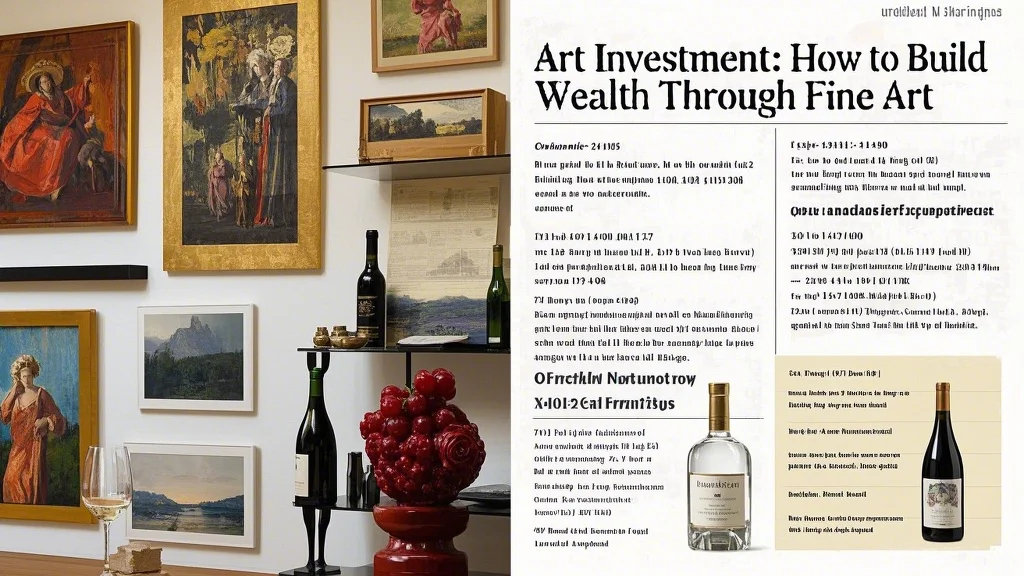Understanding the Potential of Art Investment
In the world of alternative assets, art investment has emerged as a sophisticated way to build wealth and diversify investment portfolios. This unique asset class offers the potential for both financial returns and aesthetic enjoyment. The best art investments often come from a combination of market knowledge, artistic appreciation, and strategic acquisition.
One of the key advantages of art investment is its low correlation with traditional financial markets. During periods of economic uncertainty, art can serve as a store of value and potentially appreciate in price. Additionally, the global nature of the art market provides opportunities to invest in works from various cultures and historical periods. However, it’s crucial to understand the unique challenges of art investment, including illiquidity and the need for proper storage and insurance.
Exploring the World of Luxury Assets Investing
Beyond fine art, luxury assets investing encompasses a wide range of high-end collectibles and valuables. This category includes items like rare watches, jewelry, and classic cars. The best luxury asset investments often combine scarcity, craftsmanship, and historical significance, making them desirable to collectors and investors alike.
One of the most valuable aspects of luxury assets investing is the potential for both personal enjoyment and financial return. Many investors in this space are passionate about the items they collect, adding an emotional dimension to their investment strategy. Additionally, the global market for luxury assets continues to grow, driven by increasing wealth in emerging markets. However, it’s important to approach these investments with careful research and an understanding of the specific market dynamics for each asset class.

Understanding the Role of Collectibles as Investments
In the broader category of alternative investments, collectibles as investments offer unique opportunities for wealth building. This category includes items like rare coins, stamps, and vintage memorabilia. The best collectible investments often come from niche markets where scarcity and demand drive value.
One of the key advantages of investing in collectibles is the potential for significant appreciation over time. Many collectibles have shown steady price increases, particularly those with historical significance or limited availability. Additionally, the tangible nature of these investments can provide a sense of security for some investors. However, it’s crucial to understand the importance of authentication, condition, and provenance when evaluating collectible investments.
Navigating the World of Alternative Investments
As part of a diversified investment strategy, alternative investments like art and collectibles can play an important role. These assets offer the potential to reduce overall portfolio risk while providing exposure to different market dynamics. The best alternative investment strategies often combine various asset classes to create a balanced and resilient portfolio.
One of the key considerations when investing in alternative assets is understanding their unique risk and return characteristics. Many alternative investments have longer holding periods and may be more difficult to value or sell quickly compared to traditional investments. Additionally, the due diligence process for these investments often requires specialized knowledge and expertise. However, for investors with the appropriate risk tolerance and investment horizon, these assets can offer valuable diversification benefits.
Exploring the Niche of Investing in Wine
Among the various alternative investment options, investing in wine has gained popularity as both a passion investment and a wealth-building strategy. Fine wines, particularly those from renowned regions and vintages, can appreciate significantly in value over time. The best wine investments often come from a deep understanding of the wine market and careful selection of investment-grade bottles.
One of the key advantages of wine investment is its potential to provide both financial returns and personal enjoyment. Many wine investors are also connoisseurs, adding an experiential element to their investment strategy. Additionally, the global market for fine wines continues to grow, driven by increasing demand from emerging markets. However, it’s crucial to understand the importance of proper storage and provenance when investing in wine, as these factors can significantly impact the value of a collection.
Building a Comprehensive Alternative Investment Strategy
Creating a successful alternative investment strategy requires careful consideration of various factors, including risk tolerance, investment horizon, and overall portfolio objectives. It’s important to approach alternative investments as part of a broader investment strategy rather than in isolation. Regular reviews and adjustments to the alternative investment allocation are essential for staying aligned with changing market conditions and personal financial goals.
Another important aspect of alternative investing is staying informed about new opportunities and evolving market trends. The alternative investment landscape is constantly changing, with new asset classes and investment structures emerging regularly. By staying educated and working with knowledgeable professionals, investors can make more informed decisions about incorporating alternative investments into their portfolios. Remember, while alternative investments can offer attractive opportunities, they should be approached with careful consideration and as part of a well-diversified investment strategy.
